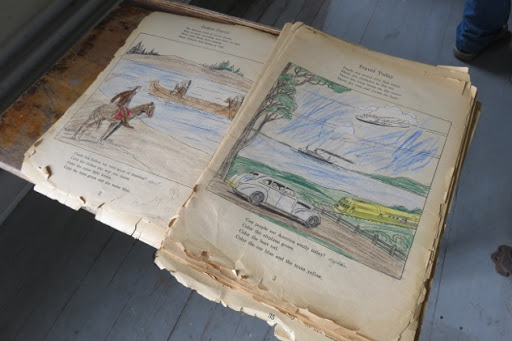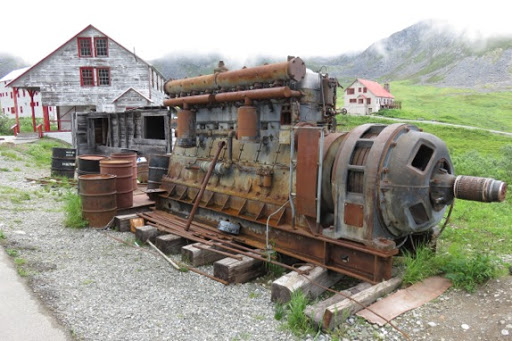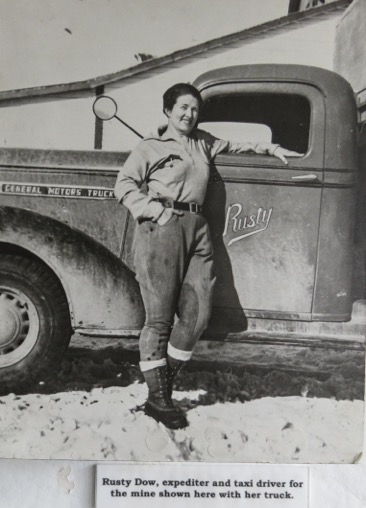Well, it’s our 3rd straight day of rain. Can’t let that stop us so we headed out to the Independence Mine State Historic Park. Long drive, climbing most of the way. Finally, we found the park, high in a bowl formed by the mountains. Looks like a beautiful day, right? Not for long.
Lots of people in the parking lot. And, then the tour buses arrived.
And, of course, the story on the mine begins with gold. In 1906, Robert Lee Hatcher staked his first claim in this area. First he found some little bits of gold in a stream, placer gold, but he found the lode, gold found in quartz within solid rock, much harder and more expensive to remove than just panning in a stream. But it wasn’t until 1937 that a full-scale mining operation was developed. By 1941 the mine, mill and office employed 204 men. Then in 1943, gold mining was declared non-essential to the war effort and gold mining was shut down. When the war was over, gold was set at $35 per ounce, not worth mining and the mine itself closed in 1951. While it was in operation, it mined 34,416 oz of gold worth $1,204,560 - or $ 17,000,000 today. In 1980 the mine was turned over to the state for a park.
We were early for the tour we signed up for so we took a short hike around the mine and its buildings. Great views of the abandoned buildings that the Alaska State Park Service hasn’t tackled yet. Many of the abandoned buildings are collapsing and imploding.
As we gathered for our tour, it began to rain buckets. Shucks, we left out raincoats in the car - we only have our nylon jackets. Oh, well. We all ran to the first building. The first accommodations were tents - above the tree line, in the winter - doesn’t that sound attractive? Then they built bunkhouses for the single men. It wads heated and plumbed and had electricity - one of the best accommodations in the area. But, it was still crowded since 25 men lived here. The whole mine is high above the tree line. Obviously, the guy at the end had seniority. He got a window and wasn’t surrounded by others.
Then there were the homes built for the married managers. This is a 4-plex, a living room and kitchen on the ground floor and an open room on the second room on top for each of the 4 families who lived here. 2 windows on the side and 1 beside the door and 1 above the door were one ‘condo.’
There were a living room and kitchen downstairs and one open room upstairs.
On a table in the living room were these: paper dolls. I remember these.
Single managers shared a room with another single manager. Note that there was steam heat throughout the buildings. The chair was hand made out of wood left over from the mine.
22 married families built their own homes near the mine in a section called ‘Boomtown’ but none of these exist now.
There was even a school for the 8 children.
The cookhouse was pretty plush - here’s a dishwasher. The owner of the mine realized that if he wanted to keep men working here, good food and a good cook were important. His cook had the best equipment and an apartment all his own.
In many ways the conditions were much better than other mines and the jobs here were coveted. Of course, the miners had to pay for the food they ate, their living quarters, the heat they used, and anything else they got from the mine. This was written on the wall in the single men’s bunkhouse - someone totaling up what they owed the company store.
However, this was still a mine and, though the conditions were better than those in other mines, it was still a mine. Shut your eyes and just imagine the sounds, the smells and the sights of this area when the mine was running full bore.
the steady thrumming of the 2 diesel engines
The continuous crunching sound of steel balls pulverizing gold-bearing quartz in the mill 24 hours a day, 7 days a week, 365 days a year.
the laughter of children playing in Boomtown echoing across the tundra,
the aroma of freshly baked bread drifting from the ovens in the mess hall,
dust clouds hanging over the delivery trucks laboring up the winding gravel road from Palmer.
the pungent odor of diesel fuel hanging in the air,
the chill of winter settling over the valley,
the sounds of the dynamite blasting in the earth every 12 hours.
The miners went into the mine for 8 hours a day laying the dynamite while the muckers cleaned up what had been blasted before. Then, as they all left, they set the dynamite off. 4 hours later, when the dust had cleared, the muckers went it and cleaned it all out while the miners placed more dynamite. The muckers were the low men on on the roster but it was they who separated the gold from the muck and rock.
Here is a partial map of the tunnels under the hill. There were at least 25 miles of tunnels.
Not many women worked here except in the office. But Rusty Dow made her living here.
After our tour we took a hike up to a glacial lake high above the mine. Cool hike but it’s in the next blog.


















No comments:
Post a Comment